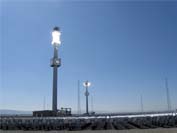CSP technology idled but definitely not out of the solar race
 Concentrated solar power (CSP) has had a tougher time of late than its photovoltaic cousin. But they say you can’t keep a good technology down.
Concentrated solar power (CSP) has had a tougher time of late than its photovoltaic cousin. But they say you can’t keep a good technology down.
That’s reaffirmed by a new Pike Research report: “Concentrated Solar Power.” The report, written by Pike Research Senior Analyst Peter Asmus anticipated that revenue from the CSP market will rise from $2.1 billion this year to $5.1 billion in 2013, but will drop in 2014. By the end of 2020, revenue could increase by up to $8.6 billion, though it may only recover to $4.8 billion from the 2013 spike.
Right now CSP, which was generating significant attention just a couple years ago as a less expensive alternative to photovoltaics, is now more expensive. “I think the main issue facing CSP is the evolution of utility-scale solar PV. It is now lower cost, easier to site, and does not require water for cooling,” Asmus said. “The challenge for most CSP technologies is that there is not that much more head room to reduce cost. The power tower has the best prospects for cost reductions, and that's why I had been bullish on BrightSource, but obviously the market did not respond well to their aborted IPO,” Asmus said.
However, there’s still hope for CSP because it can do things that traditional PV can’t, namely it can produce power when the sun’s dipped behind a cloud or even into the evening. “The focus of the CSP industry has been on how to increase value of delivered energy through technologies such as thermal energy storage,” Asmus said.
There are also other uses, like Integrated Solar Combined Cycle (ISCC) electric power plants and using CSP to provide industrial heating for applicatoins like extracting oil or natural gas. ISCC plants can be added on to existing power plants like natural gas plants. Asmus anticipates ISCC will be used in both applications but more in new power plants.
“Since the cost of natural gas pipelines and related infrastructure is easier to justify during initial project design,” Asmus said. “The ability to firm up CSP…is the primary niche the CSP industry is targeting given the declining prices of solar PV. Indeed, the value of CSP increases dramatically if power can be matched with peaks in demand, as several studies by NREL and others have clearly demonstrated.”
The largest markets for CSP in the future will likely be Europe and northern Africa, according to Asmus. “There are clearer market signals to develop large amounts of bulk renewables due to carbon mandates, and corresponding investments in bulk power transmission to serve EU markets,” he said.



